FALL TIME, PUMPKIN TIME
Although the high temperatures might still confuse us and force us to look at the calendar, the land shows us with undeniable certainty that fall is approaching.
It also does it by presenting us with colorful pumpkins popping out from the soil.
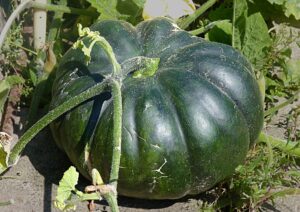
This time of the year, Italian kitchen tables begin to be covered with a selection of dishes for every part of the meal, all made of the same component.
The pumpkin is a very eclectic ingredient and can enrich both sweet and savory recipes of side dishes and desserts, as well as be the main protagonist of delicious main courses. However, the variety of shapes and colors of this vegetable, and the variety of its flavors and uses, is not always known.
There are more than 15 species, of which only five are edible.
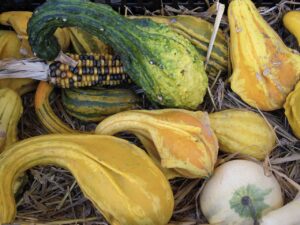
Despite the small number, the diversity of their characteristics draws an interesting panel of colors, shapes, sizes, and textures in front of our eyes.
Let’s explore some of this diversity by region and a couple of towns.
MANTUA
We take the opportunity to stop in this lovely town in the Lombardy region, because it names a famous variety (Zucca Mantovana), with a thick skin of green color – it is also known as priest’s hat for its round and slightly flattened shape. This is an ancient variety, farmed in this province for centuries. The meat is orange and has a floury texture – quite dry and tasty, which makes it perfect for the preparation of pumpkin gnocchi, as an alternative to the traditional potatoes. It can be steamed, baked, grilled, and also fried.
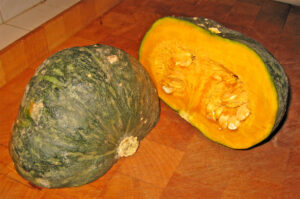
Beyond tasting the original recipes of the local pumpkin, there are many other reasons why you should stop here for a day or two; less than 30 miles from Verona, Mantua’s old town was declared a UNESCO World Heritage Site in 2008. Between the 15th and early 17th centuries, the town was an important artistic center in Northern Italy, with continental influence in the history of music, and particularly of opera. The presence of the Gonzaga family provided the power and the influence to turn this location into a rich and thriving court, cultivating arts and culture in all its forms.
MARINA DI CHIOGGIA
This town, on the Venetian Lagoon, names an easily recognizable variety of pumpkin, with a very lumpy skin of green-to-grey shades, Suca Baruca – its local name. While growing, it needs a lot of heat to reach complete maturation, but it can last for up to eight months once harvested. It’s very popular for its versatility and it’s great in the preparation of risotto.
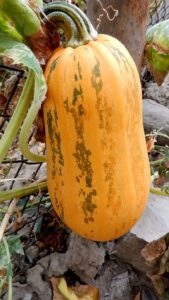
FERRARA
Butternut violin – as the name suggests, this variety has a distinctive nutty flavor.
A well-known Italian variety of this pumpkin, also widespread in the US and the UK, grows in the region of Ferrara, 30 miles from Bologna. It is called violin because of its shape, which resembles a musical instrument.
This type differs from the others, with its wrinkled surface. It’s ideal for baking and preparing jams.
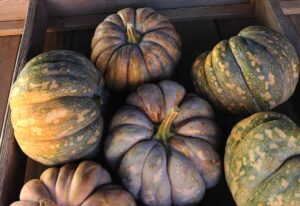
NAPLES
The variety typical of Naples and its region, Campania, has a long shape and can reach 44 pounds in weight. Its seeds are located at the base of the vegetable, not inside. It is cooked exactly like a zucchini – to which pumpkins are related – and its light or dark green skin is thin and easy to peel. The peculiarity of this pumpkin, which has a typical sweet and musky flavor, is that it can be eaten raw, in a salad, for example, but it is also great for soups and sauces.
LET’S FINISH WITH SOME PRIMI (FIRST COURSES)
After celebrating all this diversity of recipes, we would like to return to the classic; in particular, the two first courses which are traditionally associated with the season’s vegetable: the tortelli di zucca and the vellutata:
Tortelli di zucca – or pumpkin-stuffed pasta. As the name suggests, they look like big tortellini, but are filled with our vegetable, instead of meat. A way to enhance the flavor of the main ingredient is to use a simple sauce, such as butter and sage. You can dress with a few nuts on top.
Vellutata – which in Italian means velvety – is a simple and rich soup, thick in texture and slightly sweet in taste, topped with extra virgin olive oil, and possibly accompanied by some croutons.
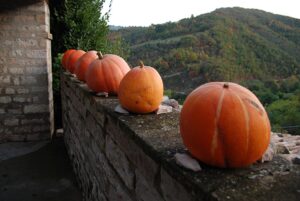
***
If you are interested in knowing more about this versatile vegetable, meeting the local farmers, and tasting the many delicacies they can create in the kitchen, you should attend the Annual Piozzo Regional Pumpkin Fair (Fiera regionale della Zucca di Piozzo), in Cuneo province, Piedmont region.
This year, between October 4th and 6th, they will celebrate the 31st event, with 600 varieties, from tiny ones to giant ones.

Contact us for a tailored exploration of the region with a full immersion in the seasonal tastes of Italy.
Words by Elisa Spampinato


